Analysis of Netflix's Demand, Supply, and Tax Implications on Pricing
VerifiedAdded on 2020/02/19
|7
|1371
|86
Report
AI Summary
This report analyzes the impact of taxation on Netflix's pricing strategy, considering the introduction of a GST tax. It examines the shifts in supply and demand curves, illustrating the resulting changes in equilibrium price and quantity. The report explores the price elasticity of demand for Netflix products, classifying them as price elastic due to the availability of substitutes. It further analyzes the impact of price changes on total revenue, demonstrating how a price increase leads to a decrease in revenue, a clear indication of elastic demand. Additionally, the report investigates the incidence of the tax, showing how the tax burden is primarily borne by producers due to the elastic nature of demand. The conclusion summarizes the key findings, emphasizing the influence of production costs on supply, the impact on demand, and the overall effect on Netflix's market dynamics.
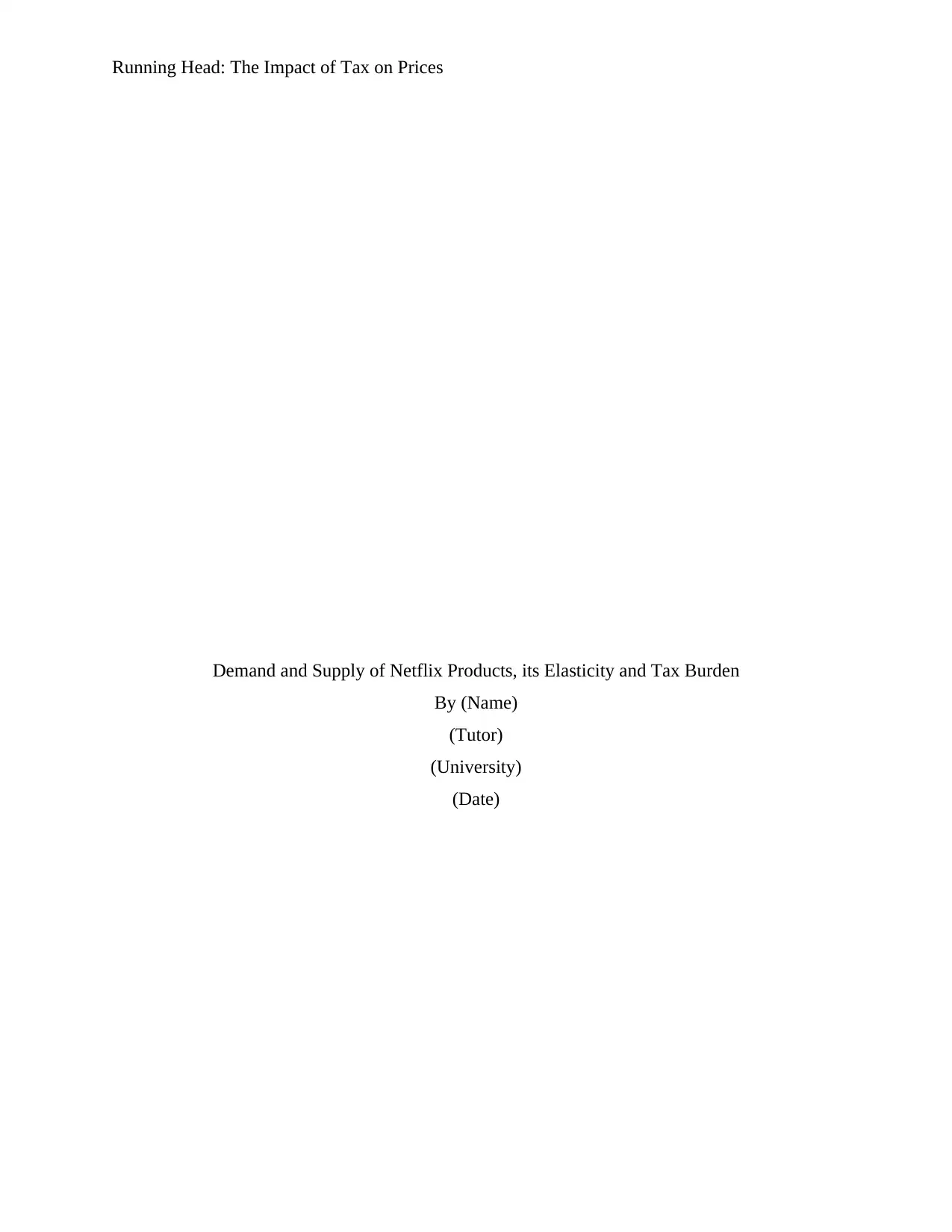
Running Head: The Impact of Tax on Prices
Demand and Supply of Netflix Products, its Elasticity and Tax Burden
By (Name)
(Tutor)
(University)
(Date)
Demand and Supply of Netflix Products, its Elasticity and Tax Burden
By (Name)
(Tutor)
(University)
(Date)
Paraphrase This Document
Need a fresh take? Get an instant paraphrase of this document with our AI Paraphraser
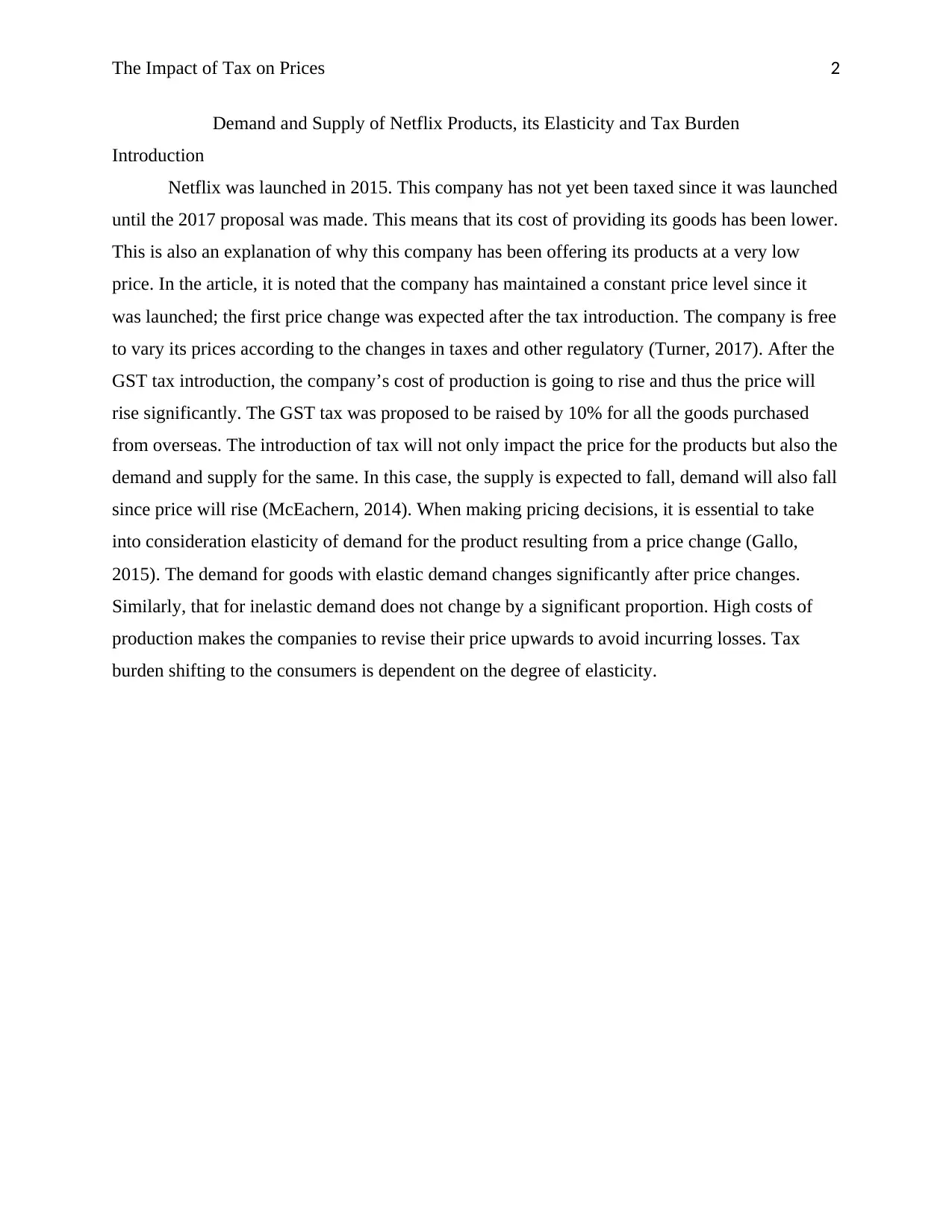
The Impact of Tax on Prices 2
Demand and Supply of Netflix Products, its Elasticity and Tax Burden
Introduction
Netflix was launched in 2015. This company has not yet been taxed since it was launched
until the 2017 proposal was made. This means that its cost of providing its goods has been lower.
This is also an explanation of why this company has been offering its products at a very low
price. In the article, it is noted that the company has maintained a constant price level since it
was launched; the first price change was expected after the tax introduction. The company is free
to vary its prices according to the changes in taxes and other regulatory (Turner, 2017). After the
GST tax introduction, the company’s cost of production is going to rise and thus the price will
rise significantly. The GST tax was proposed to be raised by 10% for all the goods purchased
from overseas. The introduction of tax will not only impact the price for the products but also the
demand and supply for the same. In this case, the supply is expected to fall, demand will also fall
since price will rise (McEachern, 2014). When making pricing decisions, it is essential to take
into consideration elasticity of demand for the product resulting from a price change (Gallo,
2015). The demand for goods with elastic demand changes significantly after price changes.
Similarly, that for inelastic demand does not change by a significant proportion. High costs of
production makes the companies to revise their price upwards to avoid incurring losses. Tax
burden shifting to the consumers is dependent on the degree of elasticity.
Demand and Supply of Netflix Products, its Elasticity and Tax Burden
Introduction
Netflix was launched in 2015. This company has not yet been taxed since it was launched
until the 2017 proposal was made. This means that its cost of providing its goods has been lower.
This is also an explanation of why this company has been offering its products at a very low
price. In the article, it is noted that the company has maintained a constant price level since it
was launched; the first price change was expected after the tax introduction. The company is free
to vary its prices according to the changes in taxes and other regulatory (Turner, 2017). After the
GST tax introduction, the company’s cost of production is going to rise and thus the price will
rise significantly. The GST tax was proposed to be raised by 10% for all the goods purchased
from overseas. The introduction of tax will not only impact the price for the products but also the
demand and supply for the same. In this case, the supply is expected to fall, demand will also fall
since price will rise (McEachern, 2014). When making pricing decisions, it is essential to take
into consideration elasticity of demand for the product resulting from a price change (Gallo,
2015). The demand for goods with elastic demand changes significantly after price changes.
Similarly, that for inelastic demand does not change by a significant proportion. High costs of
production makes the companies to revise their price upwards to avoid incurring losses. Tax
burden shifting to the consumers is dependent on the degree of elasticity.
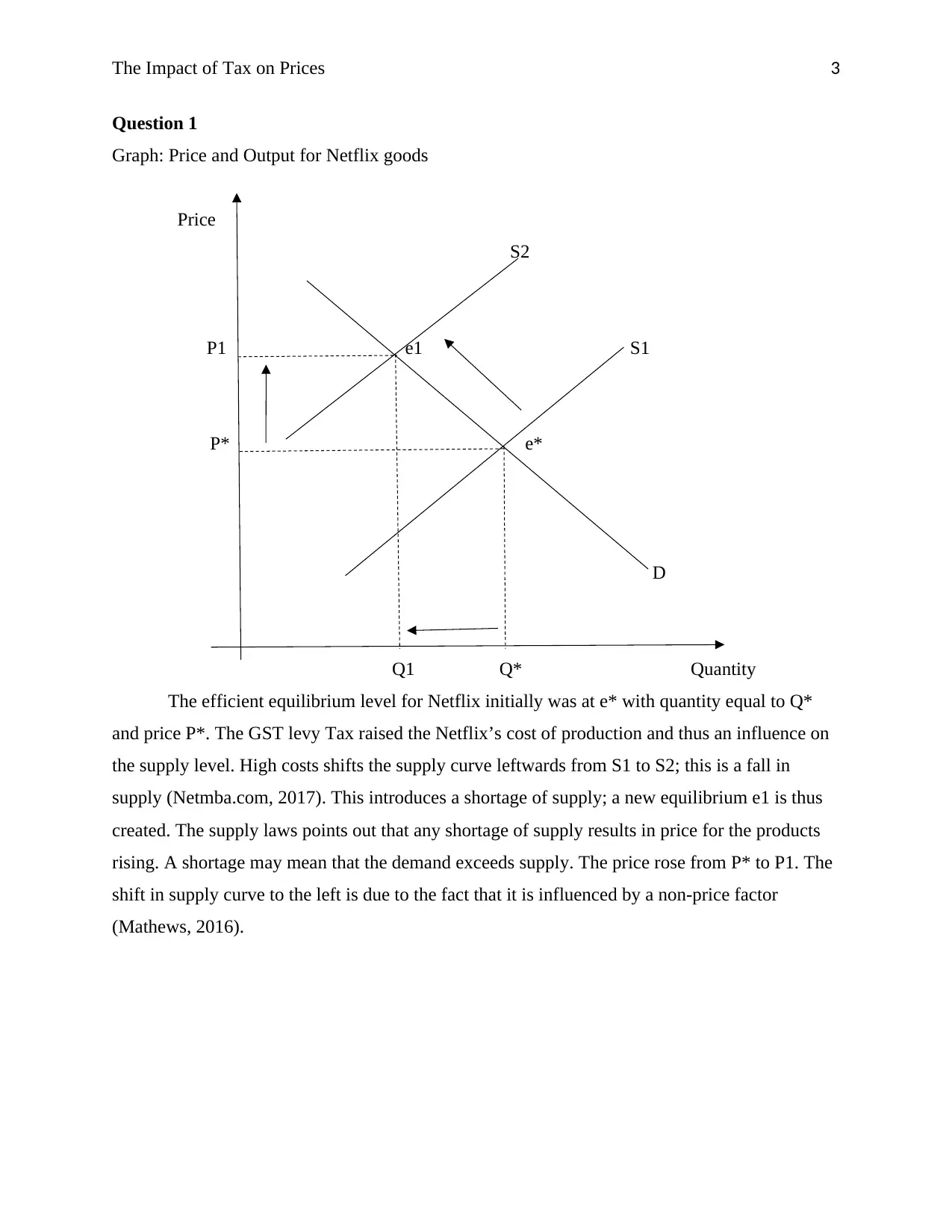
The Impact of Tax on Prices 3
Question 1
Graph: Price and Output for Netflix goods
Price
S2
P1 e1 S1
P* e*
D
Q1 Q* Quantity
The efficient equilibrium level for Netflix initially was at e* with quantity equal to Q*
and price P*. The GST levy Tax raised the Netflix’s cost of production and thus an influence on
the supply level. High costs shifts the supply curve leftwards from S1 to S2; this is a fall in
supply (Netmba.com, 2017). This introduces a shortage of supply; a new equilibrium e1 is thus
created. The supply laws points out that any shortage of supply results in price for the products
rising. A shortage may mean that the demand exceeds supply. The price rose from P* to P1. The
shift in supply curve to the left is due to the fact that it is influenced by a non-price factor
(Mathews, 2016).
Question 1
Graph: Price and Output for Netflix goods
Price
S2
P1 e1 S1
P* e*
D
Q1 Q* Quantity
The efficient equilibrium level for Netflix initially was at e* with quantity equal to Q*
and price P*. The GST levy Tax raised the Netflix’s cost of production and thus an influence on
the supply level. High costs shifts the supply curve leftwards from S1 to S2; this is a fall in
supply (Netmba.com, 2017). This introduces a shortage of supply; a new equilibrium e1 is thus
created. The supply laws points out that any shortage of supply results in price for the products
rising. A shortage may mean that the demand exceeds supply. The price rose from P* to P1. The
shift in supply curve to the left is due to the fact that it is influenced by a non-price factor
(Mathews, 2016).
⊘ This is a preview!⊘
Do you want full access?
Subscribe today to unlock all pages.

Trusted by 1+ million students worldwide

The Impact of Tax on Prices 4
Question 2a
If the substitutes for a good are found easily, the demand for that good is price elastic.
However, if the substitutes are hard to find, the demand is now price inelastic. If a product is a
necessity good, its demand is price inelastic; but if it is considered a luxury good, its demand
now becomes price elastic (Riley, 2015). It is said to be price elastic because a consumer can
avoid buying this product is prices are high. If a product is able to raise the consumers addiction,
its demand is price inelastic; but if it can’t, it is price elastic. A product with a broader definition
is price inelastic; but elastic for those with a narrower definition. The Netflix’s products are not a
necessity and thus demand is price elastic. Consumers do not have to get the products online,
they can get them from other sources at a lower price. For instance, those who streams online to
get new can rely on traditional sources.
Question 2b
Graph: Impacts of price rise on total revenues
Price
P1 b
a
P* D
A Q1 Q* Quantity
The total revenue at price P* and quantity Q* is P*Q*= area P*aQ*A. The total revenue
after price rose to P1 and quantity fell to Q1 is P1Q1 = Area P1bQ1A. The area before the tax is
larger than the area after tax; this is because the small price change resulted in a more than
proportionate drop in quantity demanded. This means that the demand for Netflix’s products is
more elastic to price changes. If the demand was inelastic to price, the company would have
raised additional revenue.
Question 2a
If the substitutes for a good are found easily, the demand for that good is price elastic.
However, if the substitutes are hard to find, the demand is now price inelastic. If a product is a
necessity good, its demand is price inelastic; but if it is considered a luxury good, its demand
now becomes price elastic (Riley, 2015). It is said to be price elastic because a consumer can
avoid buying this product is prices are high. If a product is able to raise the consumers addiction,
its demand is price inelastic; but if it can’t, it is price elastic. A product with a broader definition
is price inelastic; but elastic for those with a narrower definition. The Netflix’s products are not a
necessity and thus demand is price elastic. Consumers do not have to get the products online,
they can get them from other sources at a lower price. For instance, those who streams online to
get new can rely on traditional sources.
Question 2b
Graph: Impacts of price rise on total revenues
Price
P1 b
a
P* D
A Q1 Q* Quantity
The total revenue at price P* and quantity Q* is P*Q*= area P*aQ*A. The total revenue
after price rose to P1 and quantity fell to Q1 is P1Q1 = Area P1bQ1A. The area before the tax is
larger than the area after tax; this is because the small price change resulted in a more than
proportionate drop in quantity demanded. This means that the demand for Netflix’s products is
more elastic to price changes. If the demand was inelastic to price, the company would have
raised additional revenue.
Paraphrase This Document
Need a fresh take? Get an instant paraphrase of this document with our AI Paraphraser
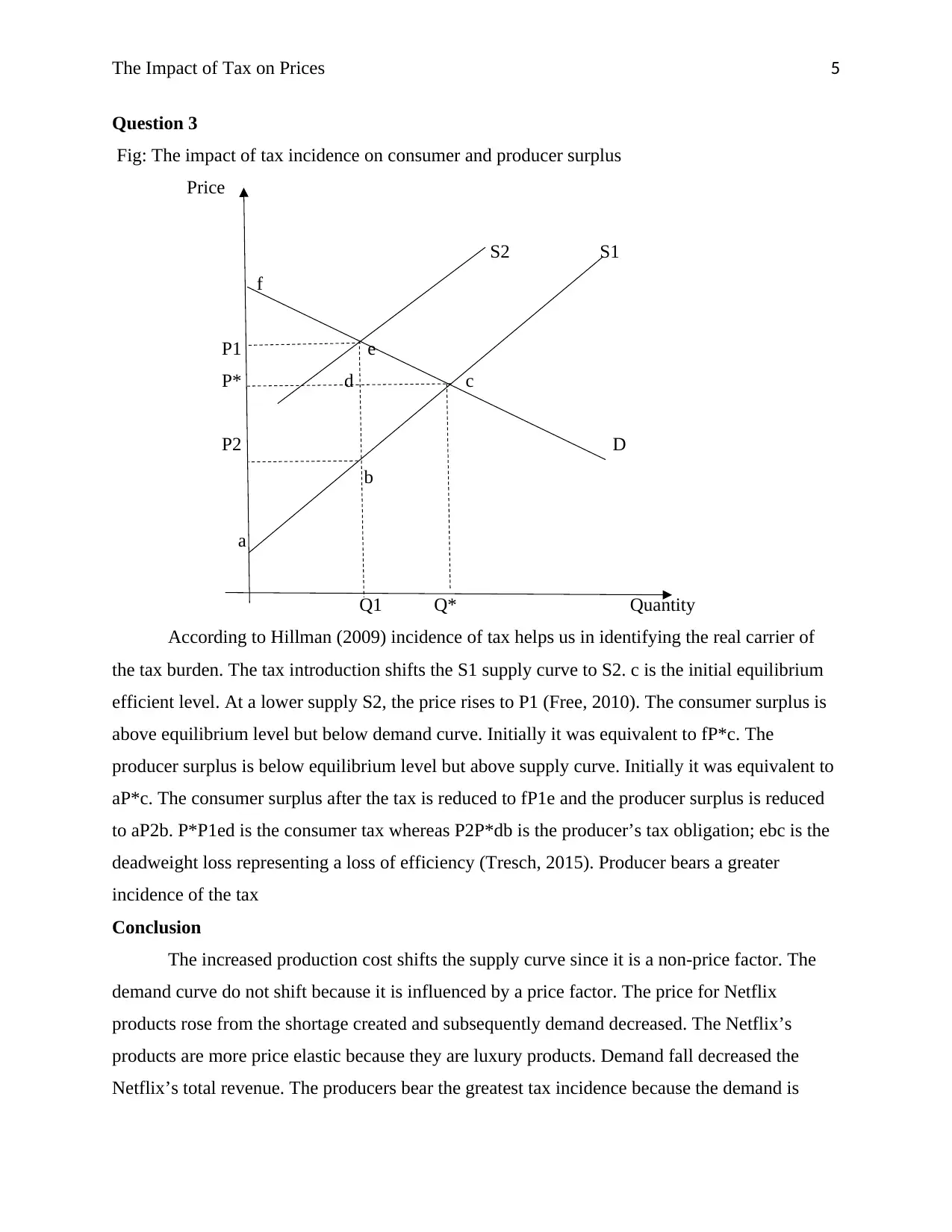
The Impact of Tax on Prices 5
Question 3
Fig: The impact of tax incidence on consumer and producer surplus
Price
S2 S1
f
P1 e
P* d c
P2 D
b
a
Q1 Q* Quantity
According to Hillman (2009) incidence of tax helps us in identifying the real carrier of
the tax burden. The tax introduction shifts the S1 supply curve to S2. c is the initial equilibrium
efficient level. At a lower supply S2, the price rises to P1 (Free, 2010). The consumer surplus is
above equilibrium level but below demand curve. Initially it was equivalent to fP*c. The
producer surplus is below equilibrium level but above supply curve. Initially it was equivalent to
aP*c. The consumer surplus after the tax is reduced to fP1e and the producer surplus is reduced
to aP2b. P*P1ed is the consumer tax whereas P2P*db is the producer’s tax obligation; ebc is the
deadweight loss representing a loss of efficiency (Tresch, 2015). Producer bears a greater
incidence of the tax
Conclusion
The increased production cost shifts the supply curve since it is a non-price factor. The
demand curve do not shift because it is influenced by a price factor. The price for Netflix
products rose from the shortage created and subsequently demand decreased. The Netflix’s
products are more price elastic because they are luxury products. Demand fall decreased the
Netflix’s total revenue. The producers bear the greatest tax incidence because the demand is
Question 3
Fig: The impact of tax incidence on consumer and producer surplus
Price
S2 S1
f
P1 e
P* d c
P2 D
b
a
Q1 Q* Quantity
According to Hillman (2009) incidence of tax helps us in identifying the real carrier of
the tax burden. The tax introduction shifts the S1 supply curve to S2. c is the initial equilibrium
efficient level. At a lower supply S2, the price rises to P1 (Free, 2010). The consumer surplus is
above equilibrium level but below demand curve. Initially it was equivalent to fP*c. The
producer surplus is below equilibrium level but above supply curve. Initially it was equivalent to
aP*c. The consumer surplus after the tax is reduced to fP1e and the producer surplus is reduced
to aP2b. P*P1ed is the consumer tax whereas P2P*db is the producer’s tax obligation; ebc is the
deadweight loss representing a loss of efficiency (Tresch, 2015). Producer bears a greater
incidence of the tax
Conclusion
The increased production cost shifts the supply curve since it is a non-price factor. The
demand curve do not shift because it is influenced by a price factor. The price for Netflix
products rose from the shortage created and subsequently demand decreased. The Netflix’s
products are more price elastic because they are luxury products. Demand fall decreased the
Netflix’s total revenue. The producers bear the greatest tax incidence because the demand is
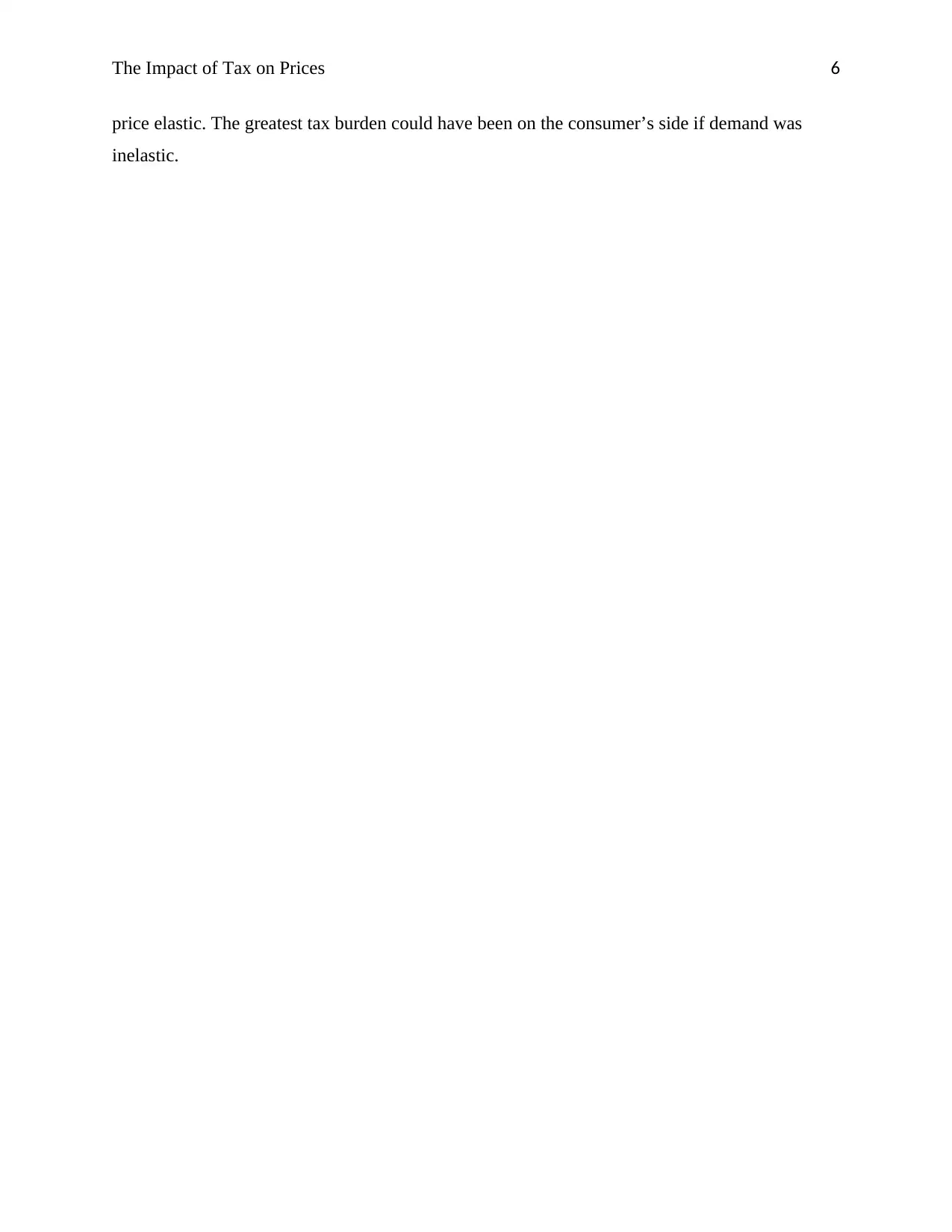
The Impact of Tax on Prices 6
price elastic. The greatest tax burden could have been on the consumer’s side if demand was
inelastic.
price elastic. The greatest tax burden could have been on the consumer’s side if demand was
inelastic.
⊘ This is a preview!⊘
Do you want full access?
Subscribe today to unlock all pages.

Trusted by 1+ million students worldwide

The Impact of Tax on Prices 7
References
Free, C. (2010). 21st century economics: a reference handbook. Thousand Oaks, Calif, Sage.
Gallo, A. (2015). A Refresher on Price Elasticity. [Online] Harvard Business Review. Available
at: https://hbr.org/2015/08/a-refresher-on-price-elasticity [Accessed 9 Sep. 2017].
Hillman, L. (2009). Public finance and public policy: responsibilities and limitations of
government. Cambridge, Cambridge University Press.
Mathews, S. (2016). In economics, what is the difference between a movement along the demand
curve and a shift in the demand curve? [Online] Quora.com. Available at:
https://www.quora.com/In-economics-what-is-the-difference-between-a-movement-along-the-
demand-curve-and-a-shift-in-the-demand-curve [Accessed 9 Sep. 2017].
McEachern, A. (2014). Economics: A contemporary introduction. Mason, OH: South-Western
Cengage Learning.
Netmba.com. (2017). Supply Curve. [Online] Available at:
http://www.netmba.com/econ/micro/supply/curve/ [Accessed 8 Sep. 2017].
Riley, G. (2015). Factors Affecting Price Elasticity of Demand. [Online] tutor2u. Available at:
https://www.tutor2u.net/economics/reference/factors-affecting-price-elasticity-of-demand
[Accessed 9 Sep. 2017].
Tresch, W. (2015). Public finance: A normative theory. Amsterdam: Elsevier.
Turner, A. (2017). Netflix slugs Aussies with price rise alongside GST tax hike. [Online] The
Sydney Morning Herald. Available at:
http://www.smh.com.au/technology/gadgets-on-the-go/netflix-slugs-aussies-with-price-rise-
alongside-gst-tax-hike-20170627-gwzw9j [Accessed 7 Sep. 2017].
References
Free, C. (2010). 21st century economics: a reference handbook. Thousand Oaks, Calif, Sage.
Gallo, A. (2015). A Refresher on Price Elasticity. [Online] Harvard Business Review. Available
at: https://hbr.org/2015/08/a-refresher-on-price-elasticity [Accessed 9 Sep. 2017].
Hillman, L. (2009). Public finance and public policy: responsibilities and limitations of
government. Cambridge, Cambridge University Press.
Mathews, S. (2016). In economics, what is the difference between a movement along the demand
curve and a shift in the demand curve? [Online] Quora.com. Available at:
https://www.quora.com/In-economics-what-is-the-difference-between-a-movement-along-the-
demand-curve-and-a-shift-in-the-demand-curve [Accessed 9 Sep. 2017].
McEachern, A. (2014). Economics: A contemporary introduction. Mason, OH: South-Western
Cengage Learning.
Netmba.com. (2017). Supply Curve. [Online] Available at:
http://www.netmba.com/econ/micro/supply/curve/ [Accessed 8 Sep. 2017].
Riley, G. (2015). Factors Affecting Price Elasticity of Demand. [Online] tutor2u. Available at:
https://www.tutor2u.net/economics/reference/factors-affecting-price-elasticity-of-demand
[Accessed 9 Sep. 2017].
Tresch, W. (2015). Public finance: A normative theory. Amsterdam: Elsevier.
Turner, A. (2017). Netflix slugs Aussies with price rise alongside GST tax hike. [Online] The
Sydney Morning Herald. Available at:
http://www.smh.com.au/technology/gadgets-on-the-go/netflix-slugs-aussies-with-price-rise-
alongside-gst-tax-hike-20170627-gwzw9j [Accessed 7 Sep. 2017].
1 out of 7
Related Documents
Your All-in-One AI-Powered Toolkit for Academic Success.
+13062052269
info@desklib.com
Available 24*7 on WhatsApp / Email
![[object Object]](/_next/static/media/star-bottom.7253800d.svg)
Unlock your academic potential
Copyright © 2020–2026 A2Z Services. All Rights Reserved. Developed and managed by ZUCOL.





